 System Tutorial
System Tutorial
 Windows Series
Windows Series
 How to Set Microsoft Edge to Automatically Clear Browser Cookies
How to Set Microsoft Edge to Automatically Clear Browser Cookies
How to Set Microsoft Edge to Automatically Clear Browser Cookies
Browsers like Microsoft Edge use “cookies” to improve your online experiences. These cookies are small pieces of data, stored within the browser. It’s thanks to them that sites you visit often remember your preferences, like if you have certain themes or “Dark Mode” enabled.
Browser cookies are useful in many ways but can also cause problems, so you might want to delete them. Edge lets you do this manually, but it’s tedious and time-consuming to do the process repeatedly. So, here’s how to clear browser cookies in Edge automatically.
Clear Browser Cookies in Edge Every Time You Close the Browser
In the Microsoft Edge Settings menu, you can configure the browser to automatically remove all cookies each time you end a session.
Here’s how to do this on desktop:
Step 1. Open Microsoft Edge and click the “Menu” button, which is represented by three little dots in the top-right corner. Then select “Settings.”
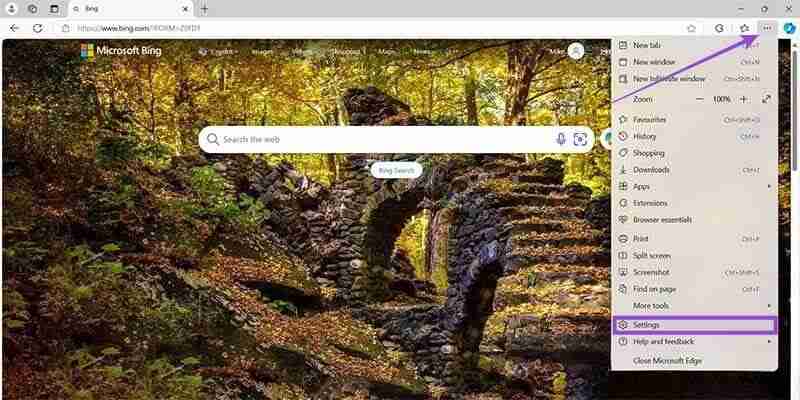
Step 2. Go to the “Privacy, search, and services” submenu located on the left side.
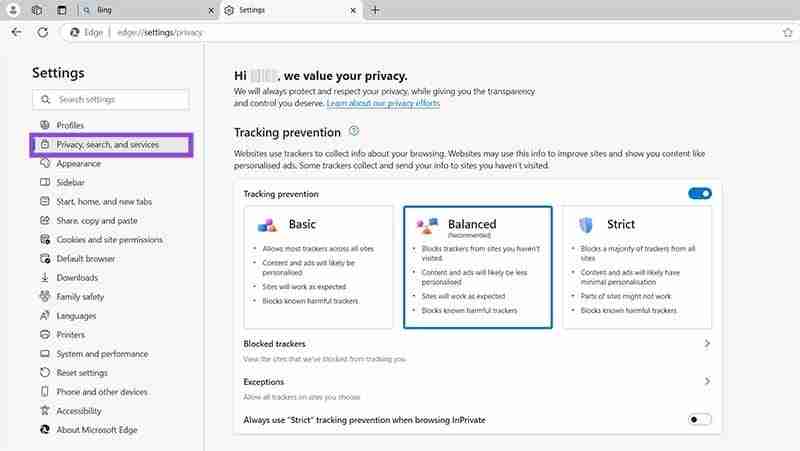
Step 3. Scroll down a little to the “Delete browsing data” section, and click on “Choose what to clear every time you close the browser.”
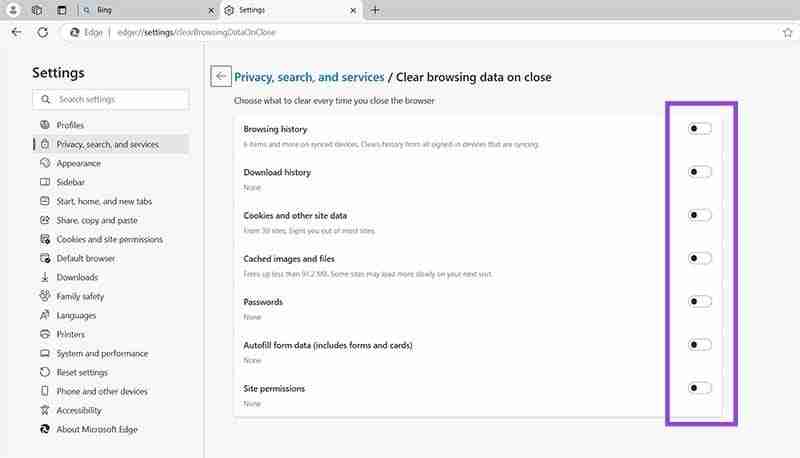
Step 4. Make sure the toggle next to “Cookies and other site data” is switched to the “On” position. Note that you can press the “Add” button to add sites you wish to keep cookies for, if you like. Otherwise, you can go back to browsing and Edge will clear cookies automatically every time you close it down.
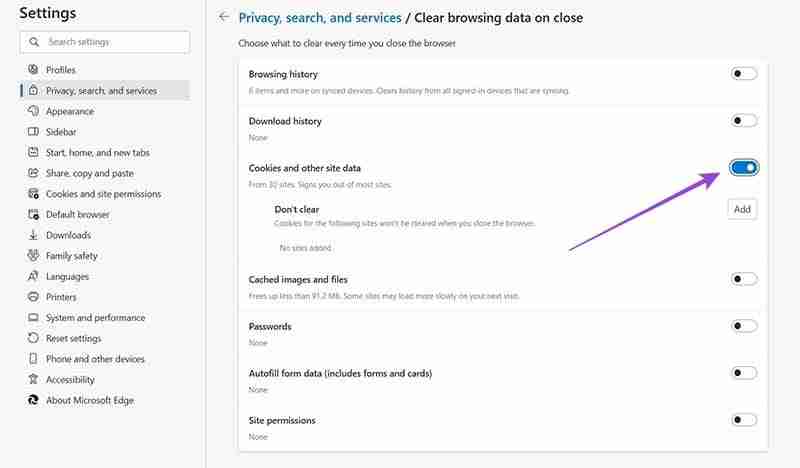
Next we’ll cover the method for the Edge mobile app. It’s very similar, but with a couple of minor differences:
Step 1. Open the Edge app and hit the three horizontal lines button to access the options. Select “Settings.”
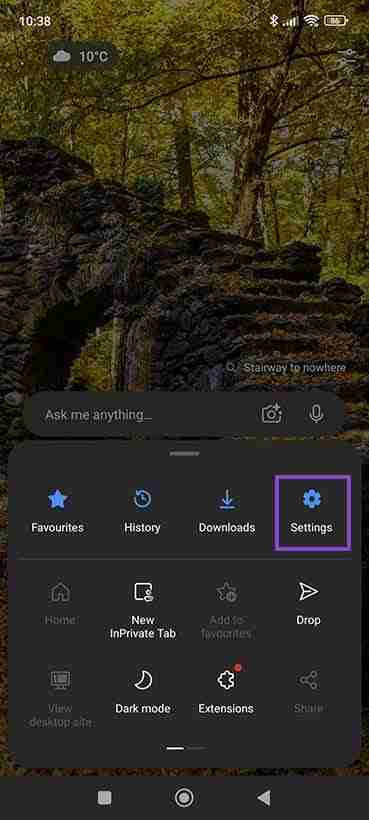
Step 2. Go to “Privacy, security and services.” Then click “Delete browsing data.”
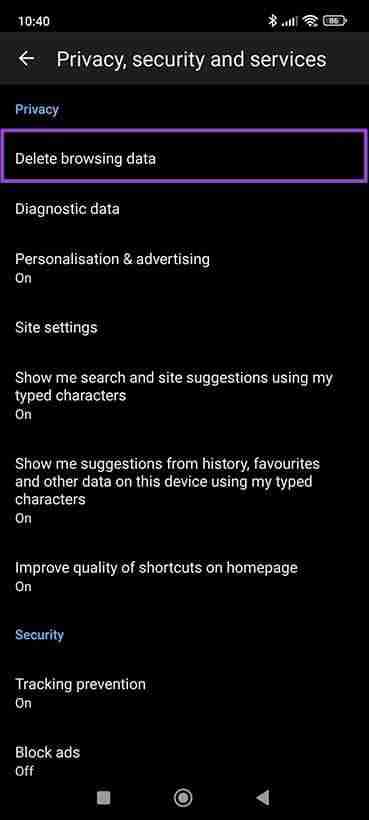
Step 3. Toggle the “Clear browsing data upon exit” switch “On” and make sure the box next to “Cookies and site data” is ticked.

Reasons to Clear Browser Cookies in Edge
Now you know how to clear browser cookies in Edge but you may wonder if it’s worth it or why to do so. Here are some reasons:
Bug-Fixing
As mentioned earlier, cookies sometimes cause problems in your browser. They might be related to bugs or error messages you keep getting when you’re trying to use Edge or access certain sites or platforms.
Clearing the cache and cookies is often a useful troubleshooting step to solve these issues. If you configure Edge to automatically delete them, you’ll have less chance of running into cookie-related bugs.
Privacy Concerns
Most cookies aren’t necessarily intrusive or unsafe but there are some cookies – specifically third-party ones – which are used by ad companies or social media platforms to gather data about you and track your activities.
That’s an issue for many people who are concerned about their online privacy and safety. Deleting cookies every time you close Edge helps make you a bit harder to keep tabs on.
When Browsing the Web on Public/Shared Devices
If you’re using a public device – like a computer at work, school, or in a library – you’ll most likely want to delete cookies. Otherwise, when you leave the device, someone else might come along, visit the same sites as you did, and get access to your personal settings and even maybe your login details.
The above is the detailed content of How to Set Microsoft Edge to Automatically Clear Browser Cookies. For more information, please follow other related articles on the PHP Chinese website!

Hot AI Tools

Undresser.AI Undress
AI-powered app for creating realistic nude photos

AI Clothes Remover
Online AI tool for removing clothes from photos.

Undress AI Tool
Undress images for free

Clothoff.io
AI clothes remover

Video Face Swap
Swap faces in any video effortlessly with our completely free AI face swap tool!

Hot Article

Hot Tools

Notepad++7.3.1
Easy-to-use and free code editor

SublimeText3 Chinese version
Chinese version, very easy to use

Zend Studio 13.0.1
Powerful PHP integrated development environment

Dreamweaver CS6
Visual web development tools

SublimeText3 Mac version
God-level code editing software (SublimeText3)

Hot Topics
 Microsoft's New PowerToys Search Is the Missing Feature Windows 11 Needs
Apr 03, 2025 am 03:53 AM
Microsoft's New PowerToys Search Is the Missing Feature Windows 11 Needs
Apr 03, 2025 am 03:53 AM
Microsoft's latest PowerToys update introduces a game-changing search feature reminiscent of macOS' Spotlight. This improved "Command Palette" (formerly PowerToys Run) surpasses the functionality of the Windows R Run command and the task
 Windows kb5054979 update information Update content list
Apr 15, 2025 pm 05:36 PM
Windows kb5054979 update information Update content list
Apr 15, 2025 pm 05:36 PM
KB5054979 is a cumulative security update released on March 27, 2025, for Windows 11 version 24H2. It targets .NET Framework versions 3.5 and 4.8.1, enhancing security and overall stability. Notably, the update addresses an issue with file and directory operations on UNC shares using System.IO APIs. Two installation methods are provided: one through Windows Settings by checking for updates under Windows Update, and the other via a manual download from the Microsoft Update Catalog.
 Why Do Some Keyboards Have Coiled Cables?
Mar 27, 2025 pm 09:01 PM
Why Do Some Keyboards Have Coiled Cables?
Mar 27, 2025 pm 09:01 PM
For mechanical keyboard enthusiasts, those intriguing coiled cables are a common sight. But why the coil? Let's delve into the reasons. Coiled Cables: Primarily Aesthetics The main draw of coiled cables is their visual appeal. They enhance the look
 These Are My Go-To Free Alternatives for Paid Windows Apps
Apr 04, 2025 am 03:42 AM
These Are My Go-To Free Alternatives for Paid Windows Apps
Apr 04, 2025 am 03:42 AM
Many free apps rival their paid counterparts in functionality. This list showcases excellent free Windows alternatives to popular paid software. I firmly believe in using free software unless a paid option offers a crucial, missing feature. These
 How to Disable Windows 11 Round Corners: 4 Easy Methods!
Mar 27, 2025 pm 03:27 PM
How to Disable Windows 11 Round Corners: 4 Easy Methods!
Mar 27, 2025 pm 03:27 PM
This guide provides four methods to remove the rounded corners in Windows 11, restoring the classic square-edged look. While the rounded corners offer a modern aesthetic, some users prefer the sharper look for reasons including improved screenshot a
 You Can Get This Powerful Mini PC for Under $150 Today
Apr 02, 2025 am 03:55 AM
You Can Get This Powerful Mini PC for Under $150 Today
Apr 02, 2025 am 03:55 AM
Kamrui GK3Plus Mini PC: Small and powerful, affordable! During Amazon's spring sale, the Kamrui GK3Plus Mini PC is priced as low as $150! This mini computer has powerful performance, easy upgrade and small size, making it an ideal choice for users who pursue cost-effectiveness. Whether it’s a mini computer enthusiast or a first-time user who’s trying out a small computer, the Kamrui GK3Plus Mini PC is an excellent starter choice. Originally priced at $199, Amazon currently enjoys a 15% discount (and a $20 coupon) and can be purchased for less than $149. Such a affordable price, but with a good configuration: equipped with a slightly old but competent In
 Microsoft Might Finally Fix Windows 11's Start Menu
Apr 10, 2025 pm 12:07 PM
Microsoft Might Finally Fix Windows 11's Start Menu
Apr 10, 2025 pm 12:07 PM
Windows 11's Start Menu Gets a Much-Needed Overhaul Microsoft's Windows 11 Start menu, initially criticized for its less-than-intuitive app access, is undergoing a significant redesign. Early testing reveals a vastly improved user experience. The up
 Nanoleaf Wants to Change How You Charge Your Tech
Apr 17, 2025 am 01:03 AM
Nanoleaf Wants to Change How You Charge Your Tech
Apr 17, 2025 am 01:03 AM
Nanoleaf's Pegboard Desk Dock: A Stylish and Functional Desk Organizer Tired of the same old charging setup? Nanoleaf's new Pegboard Desk Dock offers a stylish and functional alternative. This multifunctional desk accessory boasts 32 full-color RGB





